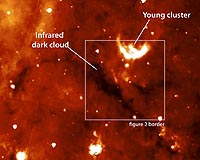 |
Boston MA (SPX) Jun 12, 2009 A new image from NASA's Chandra X-ray Observatory shows a supernova remnant with a different look. This object, known as SNR 0104-72.3 (SNR 0104 for short), is in the Small Magellanic Cloud, a small neighboring galaxy to the Milky Way. Astronomers think that SNR 0104 is the remains of a so-called Type Ia supernova caused by the thermonuclear explosion of a white dwarf. In this composite made of X-rays from Chandra shown in purple and infrared data from Spitzer shown in green and red, SNR 0104 looks unlike other likely Type Ia remnants found in our own Galaxy. While objects such as the Kepler and Tycho supernova remnants appear circular, the shape of SNR 0104 in X-rays is not. Instead, the image is dominated by two bright lobes of emission (seen to the upper right and lower left). The large amount of iron in these lobes indicates that SNR 0104 was likely formed by a Type Ia supernova. One possible explanation for this structure is that the explosion of the white dwarf itself was strongly asymmetrical and produced two jets of iron. Another possibility is that the complicated environment seen in the image is responsible. The green shells on the left and right side of SNR 0104 correspond to surrounding material that has been swept up by the explosion. So, the unusual shape of the remnant might be caused by a lack of material to the north and south of the star to interrupt the outward path of the stellar debris. This explanation, however, is still in question and scientists hope more data from Chandra and other telescopes will help settle the debate. The presence of a nearby massive star and the shells of gas and dust seen in the wide-field view from Spitzer shows that SNR 0104 might be located within a star-forming region. This suggests that SNR 0104 may belong to a little-studied class of so-called "prompt" Type Ia supernovas caused by the demise of younger, more massive stars than average. Again, more data will be needed to test this theory. This research was led by Sangwook Park and Jae-Joon Lee of Penn State University and was presented at the 214th meeting of the American Astronomical Society in Pasadena, California. NASA's Marshall Space Flight Center in Huntsville, Ala., manages the Chandra program for NASA's Science Mission Directorate in Washington. The Smithsonian Astrophysical Observatory controls Chandra's science and flight operations from Cambridge, Mass. Share This Article With Planet Earth
Related Links Chandra Stellar Chemistry, The Universe And All Within It
 Submillimeter Array Finds Massive Core In Cold Dark Cloud
Submillimeter Array Finds Massive Core In Cold Dark CloudManoa HI (SPX) Jun 12, 2009 Astronomers using the Submillimeter Array atop Mauna Kea in Hawaii have found a massive, quiescent object in a dark cloud that is likely to be the direct progenitor of a massive star or stars. Dr. Jonathan Swift of the Institute for Astronomy at the University of Hawaii at Manoa is presenting these results at a press conference at the American Astronomical Society meeting in Pasadena, California ... read more |
|
| The content herein, unless otherwise known to be public domain, are Copyright 1995-2009 - SpaceDaily. AFP and UPI Wire Stories are copyright Agence France-Presse and United Press International. ESA Portal Reports are copyright European Space Agency. All NASA sourced material is public domain. Additional copyrights may apply in whole or part to other bona fide parties. Advertising does not imply endorsement,agreement or approval of any opinions, statements or information provided by SpaceDaily on any Web page published or hosted by SpaceDaily. Privacy Statement |